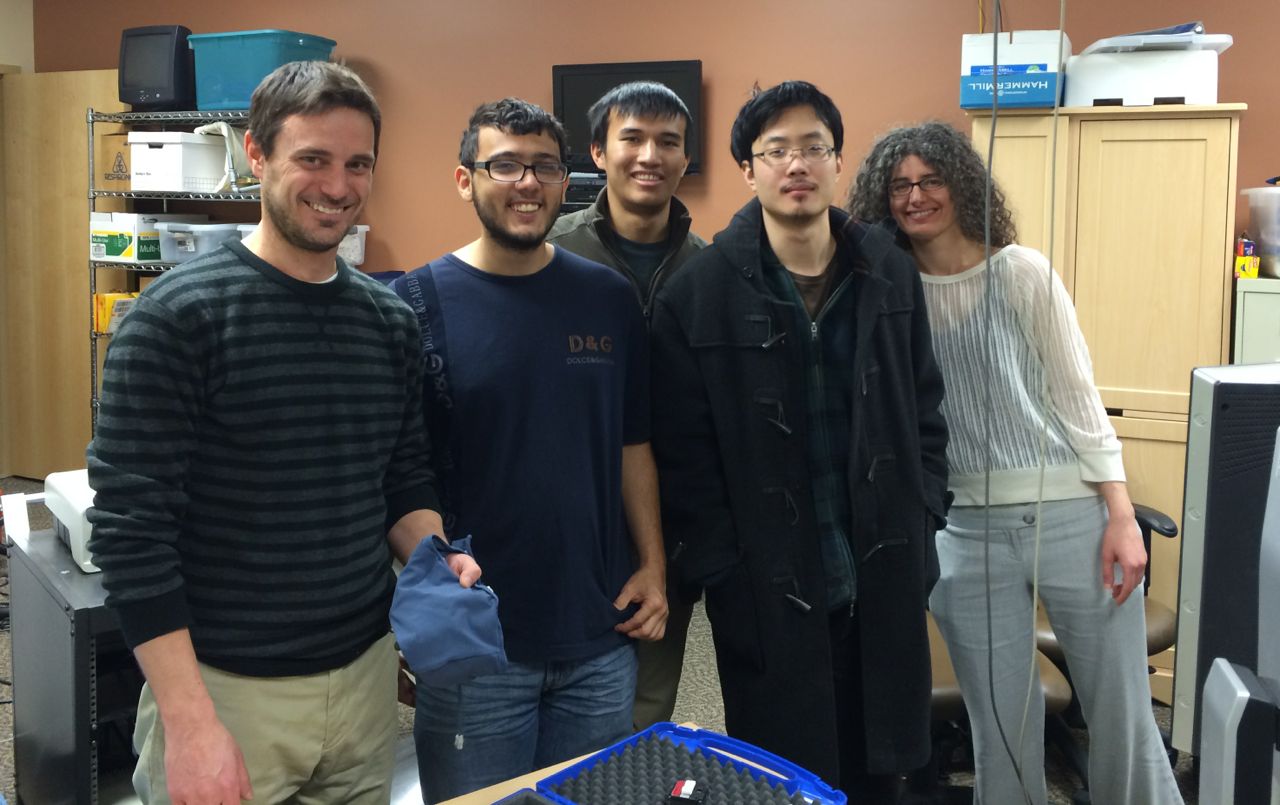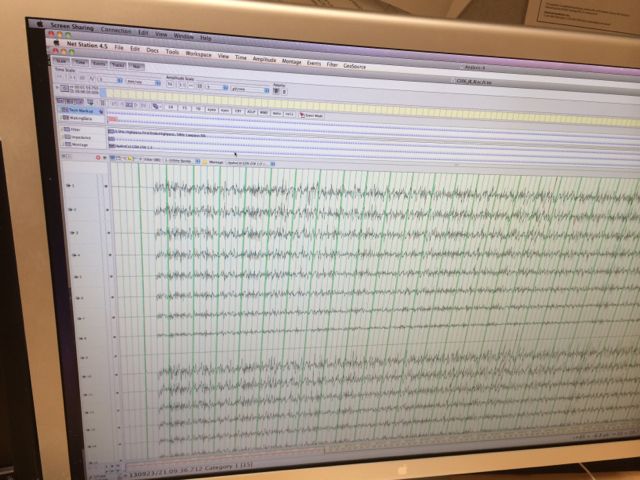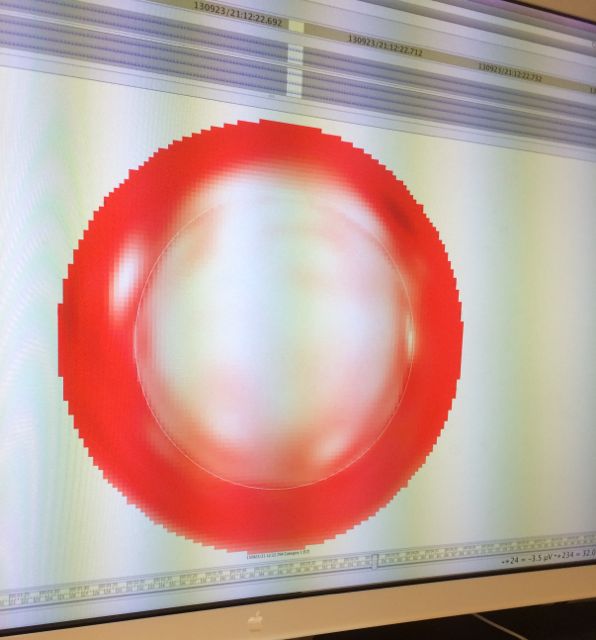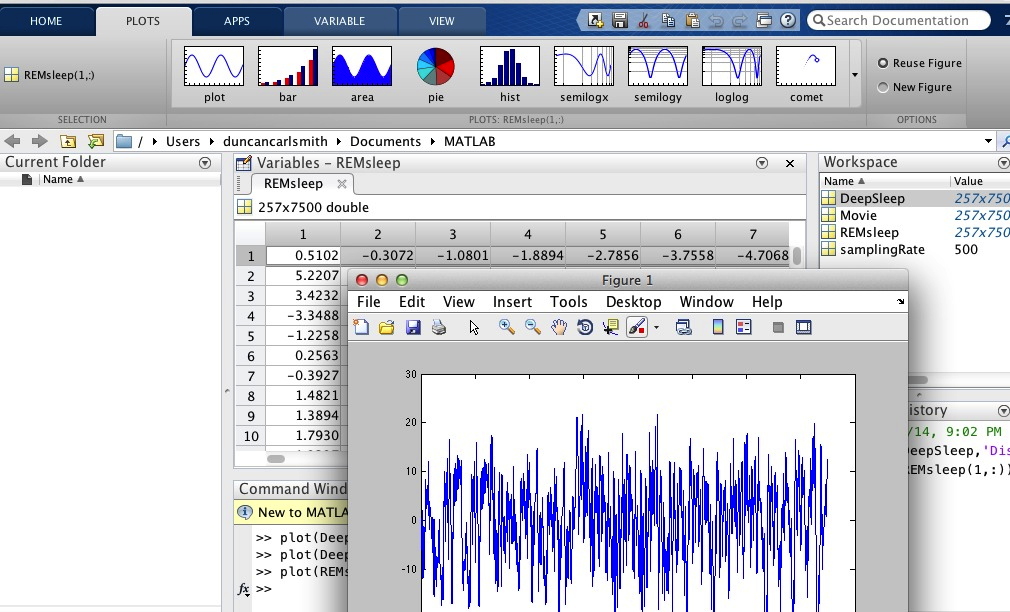EEG/BCI





Goal: To build an EEG that has enough resolution to read a person's mind and interpret what his/her thoughts into a known command. This involves building both the hardware and the computer software that interrupts the data. We might have an EEG borrowed for a semester (and a semester only) from the NITRO lab on campus (http://nitrolab.engr.wisc.edu/) so we can check the differences and improve our eeg. This project is going to be used in conjunction with the quadcopter to make a mind controlled quadcopter! You can also use it in other projects with very little modifications. Think of all the new cool possibilities!
Current progress: Group meeting: Carlsmith, Saif, Wangden with UWPIC. Pix above. Evaluating commerical EEG hardware. Received sample data.
People involved in the project:
- Ahmed Saif
- Duncan Carlsmith
- Tenzin Wangden
- Paul Jung
with help from UWPIC scientists
- Daniela Dentico
- Brady Riedner
A paper of a technique to obtain real time pattern recognition for BCI:
http://iopscience.iop.org/0957-0233/22/2/025802/pdf/0957-0233_22_2_025802.pdf
Quadcopter control in three-dimensional space using a noninvasive motor imagery-based brain–computer interface
http://iopscience.iop.org.ezproxy.library.wisc.edu/1741-2552/10/4/046003/article , http://www1.umn.edu/news/news-releases/2013/UR_CONTENT_445216.html, http://www.tc.umn.edu/~binhe/bhe.htm
RC Helicopter BCI control http://www.plosone.org/article/info%3Adoi%2F10.1371%2Fjournal.pone.0026322
Tweeting by thinking http://content.time.com/time/specials/packages/article/0,28804,1934027_1934003_1933954,00.html
Software http://www.schalklab.org/research/bci2000, http://ieeexplore.ieee.org.ezproxy.library.wisc.edu/xpl/articleDetails.jsp?arnumber=1300799
Nitrolab (UW) http://nitrolab.engr.wisc.edu/collaborators.php
Adam Wilson(Cincinnati) http://med.uc.edu/neurosurgery/directory/directory/profile.aspx?epersonID=wilso3jn
Ben He (UMinn) http://www.tc.umn.edu/~binhe/bhe.htm
Some inspirational links:
http://www.youtube.com/watch?v=-h3kiws4I54 (mind controlled quadcopter)
http://www.washington.edu/news/2013/08/27/researcher-controls-colleagues-motions-in-1st-human-brain-to-brain-interface/ (a mind to mind interface)
http://www.newscientist.com/article/dn18603-mindcontrolled-prosthetics-without-brain-surgery.html#.Uk87R50o5aQ (a mind controlled prosthetic)
Minnesota students http://www.aero-news.net/index.cfm?do=main.textpost&id=205567aa-ee5f-404c-824d-a97e37230e7c
a headband that senses your brainwaves and lets you do stuff with your mind http://interaxon.ca/products.html
If interested contact Ahmed Saif at saif@wisc.edu
Ahmed,
Mind controlled quadcoptor. Awesome plan, Ahmed. You are a busy bee.
FYI, I've my paws on an RC regular helicoptor with video camera. The camera can be turned on and off remotely but there is no live streaming or GPS etc. Data is stored on a microcard. I've a trip early next week. We can play with it at the end of the week. This is not to replace your quadcoptor! On the quadcopter and this project, you are welcome to pitch directly to Physics 249 MWF 9:55. Let me know. I'm sure Professor Winokur would permit you to pitch to Physics 247.
Please add to your EEG project wiki immediately an initial evaluation of safety. Hooking up a person electrically in any fashion is definitely cause for concern. The design must ensure there is no unsafe failure mode. Any testing or operation may require special circumstances.
I cc here sleep scientist Daniel Dentico from UW Psychiatric Inst. who I hope will provide advice on construction and safety, and possibly join/assist your project. She and I have had some discussions of sleep in humans and other animals. It is fascinating stuff.
Daniela - who is the physics student who was working in your lab? I forget...
-Duncan
Resources on BCI
http://www.frontiersin.org/neuroengineering/researchtopics/interaction_of_bci_with_the_un/2020
DARPA call for proposals
http://www.acq.osd.mil/osbp/sbir/solicitations/sbir20131/darpa131.htm
SB131-002 TITLE: Portable Brain Recording Device & App
TECHNOLOGY AREAS: Biomedical, Human Systems
OBJECTIVE: The effort will develop a portable, inexpensive, and easy-to-use electroencephalography (EEG) device and corresponding mobile application (app) for use by nontraditional audiences. The product will provide real-time, quantitative assessments of neural activity, utilizing display and analyses platforms people already own.
DESCRIPTION: EEG technologies provide recordings of electrical brain activity with millisecond scale temporal resolution. These devices are used extensively in research and medical communities, including triaging for traumatic brain injury (TBI; Naunheim et al., 2010), because of their unparalleled temporal fidelity and non-invasive nature, using electrodes placed on the scalp. More recently EEG has been used in neuromarketing and to provide neurofeedback with brain computer interfaces to allow people to move objects or play computer games with their mind.
Despite these advantages and applications of EEG, historically the devices and analysis software are too expensive to promote use by a wide audience. Current research-grade EEG devices are also unappealing for the general population, with gel-based electrodes and cumbersome software programs, and unwieldy for military operational use, with many recording electrodes and wires. The commercial systems that are available and could potentially be used by a wider audience either remain expensive, are scientifically suspect, or are not flexible with regards to electrode number and placement.
Industry has recognized the need for a portable, easy-to-use EEG and a number of companies have developed simplified systems. Many of these devices, which cost $500 for the headset, are plagued by high artifact in recordings and do not provide the fidelity of data needed for valid research and operational use. These devices are typically comprised of one or only a handful of sensors with fixed locations on the scalp. This low number and lack of flexibility in recording locations drastically limits the ability to use these devices to collect quality recordings for research. Typically these commercially available portable EEG systems are used for biofeedback and gaming communities. Portable EEG systems that do provide research quality data are prohibitively costly for use by a wide audience, costing over $25k per EEG system.
There is a great need for inexpensive and easy to use neural recording devices. Having EEGs in every classroom in America would engage students in science and technology in a way not previously possible in the field of neuroscience. Teachers could design lesson plans in biology about the brain and sensory systems, and use hands-on demonstrations to engage students. Students could record their own brain activity and download the data to their iPad. Including EEGs in basic military first aid kits would also help with both medical diagnostics and clinical care for deployed soldiers. Portable EEGs could be used in the field, with data sent to a corresponding app on a smartphone for near-instantaneous analysis. The Department of Defense has an interest in encouraging science, technology, engineering and mathematics (STEM) pursuits, and developing a low-cost, flexible EEG device with advantages over state of the art technologies would allow many researchers to address basic and applied EEG issues in a DoD-salient fashion, ranging from building algorithms to detect incipient sleep, to diagnosing or triaging pre-clinical Post Traumatic Stress Disorder symptoms, to providing low-cost interfaces for computer training and education which modulate student feedback based on brain state.
The proposed device would provide three significant advantages over current technologies: 1) a reduced price, costing around $30 to allow widespread use by schools and average citizens, 2) easy to use sensors that could be placed in multiple locations on the head to record activity in various brain regions, and 3) the ability to download information directly to a personal tablet or mobile phone without requiring a proprietary interface or dongle.
By funding a small business with expertise in developing a portable EEG, DARPA stands to make unprecedented strides in this technology. Focusing on reducing the cost and increasing the operational ease of use for both EEG recordings and analyses will revolutionize public- and military-based access to brain science. With public-access to brain recording devices and apps, the field of cognitive neuroscience will be able to take advantage of crowd-sourcing to solve complex neuroscience problems. What challenges one laboratory of neuroscientists or even a field of scientists cannot answer, people everywhere will be able to solve collectively (Ekins and Williams 2010, Howe 2008).
PHASE I: Develop an initial concept design and model key elements for a low-cost, portable EEG system. Design a concept for an app for mobile devices that could wirelessly download EEG recordings and graphically display data. Phase I deliverables will include a technical report and brief describing the plan of approach and key technological milestones for the development of a prototype system.
PHASE II: Develop, demonstrate, and validate the concept design created in Phase I for the low-cost EEG device (~$30). Construct and demonstrate the operation of a prototype for this device in a relevant environment. In parallel to this EEG development, develop, test, and demonstrate validity of an EEG-compatible app for mobile devices. Required Phase II deliverables will include the prototype EEG sensor and compatible application, and a technical report and brief describing 1) the system design and test results for the EEG device, 2) the mobile device app, 3) and feasibility of use in future commercial and/or military applications.
PHASE III APPLICATIONS: A portable, low-cost EEG device and handheld app for analysis would aid all branches of the US military, with particular applicability to the US Army. Soldier medics with access to EEG on the battlefield would have improved diagnostic capabilities, essential to effective treatment. EEG has been shown effective as a quick triage method for TBI. EEG crowd-sourcing systems could attack multiple areas discussed above, ranging from brain-computer interfaces to driving innovative feedback regimes for digital tutor or electronic learning systems (including extant systems being acquired by the Navy and other DoD entities for operational use).
Many commercial entities would have interest in a low-cost, portable, and easy-to-use EEG. Potential marketplace applications exist in neuro-marketing, gaming, politics, and many other fields. In addition to Army medics, civilian doctors could use this device for triaging TBI patients in hospitals.
A great opportunity exists in the STEM education field as well. Placing these devices in every school would provide an invaluable resource to inspire the next generation of scientists and engineers in America and would provide an unprecedented opportunity for crowd-sourcing in the general population.
REFERENCES:
1) Ekins S and Williams AJ. 2010. Reaching out to collaborators: crowdsourcing for pharmaceutical research. Pharm Res. 27(3):393-5.
2) Howe J. 2008. Crowdsourcing: why the power of the crowd is driving the future of business, New York, Crown Publishing Group.
3) Naunheim RS, Treaster M, English J, Casner T, Chabot R. 2010. Use of brain electrical activity to quantify traumatic brain injury in the emergency department. Brain Inj. 24(11):1324-9.
KEYWORDS: Neural recordings, mobile device